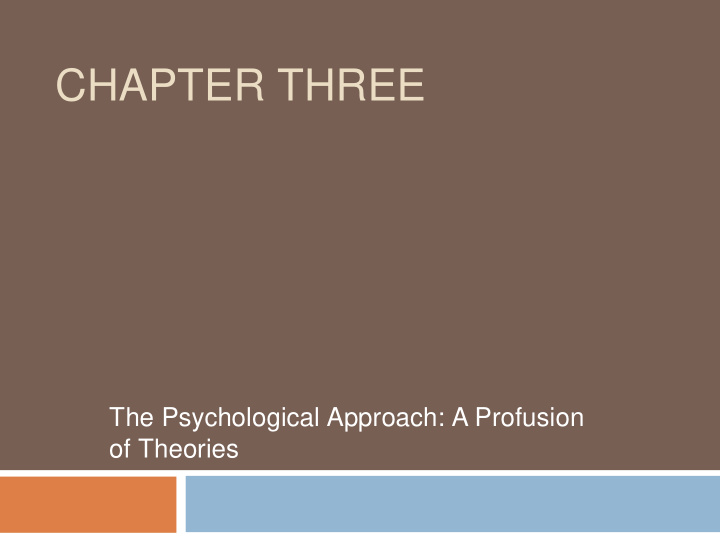



CHAPTER THREE The Psychological Approach: A Profusion of Theories
Psychology The scientific study of mind and behavior. Uses the scientific method as a means of gaining knowledge. Investigates internal mental events such as reasoning, language, and memory. Also investigates external behaviors such as talking, walking, and grasping.
The Scientific Method A theory is a general understanding of the world that organizes a set of facts and aids us in understanding how the world works. A hypothesis is a more specific statement about the world that is frequently derived from a hypothesis and can be tested.
Experiments Scientists use experiments to test hypotheses. An experiment must have at least two variables. The independent variable is manipulated by the researcher. The dependent variable is measured by the researcher.
Experiments An experiment must also have at least two conditions or groups. The experimental group receives the independent variable. The control group does not.
Experiments – An Example Theory: Practice facilitates problem solving. Hypothesis: Doing logic problems before being tested will increase scores on a subsequent logic test.
Experiments – An Example Experimental Control group: group: • 20 participants. • 20 participants. • Not allowed to • Allowed to practice practice. solving problems for 10 minutes. • Given the same test problem. • Then given a test problem. • Dependent variable • Independent is scores on the test. variable is practice.
Experiments – An Example Scores on the dependent variable for the two groups are compared. If test scores in the experimental group are significantly higher, then the hypothesis is supported.
Voluntarism Wilhelm Wundt (1832-1920) is founder. View that the mind is made up of elements. The elements are assembled into wholes through an act of will. Influenced by atoms and molecules of chemistry.
Introspection Method used by the voluntarists and other early psychologists. Means “ inner looking. ” Consists of subjective self-report of mental states. Fraught with difficulties.
Structuralism Edward Titchener (1867-1927) considered founder. Shares the beliefs that mind is made of elements and use of introspection with voluntarism. But viewed element combination occurring through passive mechanical laws.
Functionalism Closely associated with William James (1842- 1910). Focus is on mental processes and functions rather than elements. Idea of a stream of consciousness . Thought is flowing and changing, not static.
Gestalt Psychology Contributors include Wertheimer (1880-1943), Kohler (1887-1967), and Koffka (1886-1941). View that mind consists of wholes that are more than the sum of their parts, described as a gestalt. Method was phenomenology , a subjective description of an external stimulus.
Laws of Perceptual Organization Parts group together based on their relationships. Parts that are (a) proximal, (b) similar, and form (c) closed or (d) good figures tend to go together.
Insight Learning Initial attempts to solve a problem fail. Problem is put aside for some time. Solution occurs rapidly, perhaps through unconscious processes, and is then verified. Kohler ’ s chimp incubates on a problem.
Psychoanalytic Psychology Established by Sigmund Freud (1856-1939). Mind is made up of “ mini-minds ” that compete for control. Three states of consciousness: Conscious 1. Preconscious 2. Unconscious 3.
Psychoanalytic Psychology In addition, three primary mental structures: Id . Runs on the 1. pleasure principle. Superego . Runs on 2. the idealistic principle. Ego . Runs on the 3. reality principle.
Behaviorism The mind of an organism (O) is a “ Black Box. ” It cannot be studied. Focus is instead on behaviors or responses (R). Responses can be controlled through stimuli (S).
Types of Learning Classical conditioning: Operant conditioning: Unconditioned stimulus Reinforcement. • • (US). Punishment. • Unconditioned response • (UR). Conditioned stimulus • (CS). Conditioned response • (CR).
Interdisciplinary Crossroads: Studying Grouping Quantitatively Kubovy and Wagemans (1995) showed six lattice types to observers. They reported which way the dots grouped. The likelihood of grouping was plotted as a function of the distances between dots. The resulting attraction function showed an exponential increase.
Recommend
More recommend